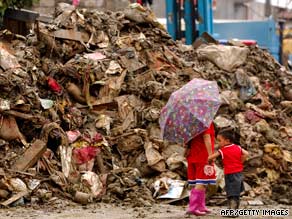Typhoon strengthens as it nears the Philippines
(CNN) -20.10.09- As the Philippines tried to recover from the one-two punch of deadly storms, another typhoon strengthened as it rushed toward it Tuesday.

A mother and her child walk past debriseft by two earlier storms in Marikina, on the suburbs of Manila, on Monday
Lupit had intensified, with winds clocked at 109 mph (175 kph) Monday.
The agency was rushing to get relief supplies to the northern part of the island of Luzon, the first place where the storm is predicted to hit, a spokeswoman said.
Early Tuesday, the storm was about 510 miles (820 km) east of Cagayan, the northernmost province of Luzon.
Relief agencies fear landslides and storm surges from Lupit -- locally known as Ramil -- could unleash further devastation on a nation already reeling from the recent Tropical Storm Ketsana and Typhoon Parma.
The death toll from both storms stood at 858 on Tuesday.
Ketsana, also known as Ondoy, drenched the Philippines with its heaviest rainfall in 40 years when it hit on September 26. Eighty percent of the capital, Manila, flooded.
By Tuesday, the death toll from Ketsana stood at 420, with 37 more missing.
More than three weeks later, some areas remain under waist-high water, the disaster coordinating council said. About 189,000 residents remain in evacuation centers.
On October 3, Typhoon Parma made landfall in a rural region of fishermen and farmers in Luzon, the largest of the Philippine islands.
Parma destroyed 55,000 houses and killed 438 people. Fifty-one others were still missing.

No comments:
Post a Comment